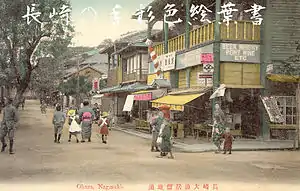Nagasaki foreign settlement
The Nagasaki foreign settlement (長崎居留地), sometimes called the Oura foreign settlement (大浦居留地), was an area in Nagasaki, Japan, settled by foreigners as Japan opened its doors to Western trade. The area was established by treaties between the West and Japan in the mid-to-late 1850s, and remained an important center of Western life in Japan until the outbreak of World War II.

This settlement saw many firsts for Japan, including the first international telegraph[1] and also the first use of a steam locomotive, the "Iron Duke," on a short track in the Oura district.[2]
Nagasaki holds a festival in mid-September that focuses on the foreign settlement.[3]
Development
A series of encounters between the West and Japan in the 1850s ended Japan's isolationist trade policies. In particular, the treaty with Russia, signed on February 7, 1855 established Nagasaki as an open port and, further, granted extraterritoriality privileges to foreigners living in Japan.[4] These encounters finally culminated in 1859 when the Ansei Treaties, and in particular the Harris Treaty with the United States, took effect. These treaties demanded immediate opening of ports, and also established generally unequal trade relationships between the Western powers and Japan.[4]
In 1860 development of the area around Oura Creek began; by August 15, 1862, Japanese officials ordered foreign residents of Nagasaki into this new settlement area.[1]
Decline and dismantling
By 1894, the treaties that led to the formation of the foreign settlement had been abolished, and new ones became effective in 1899.[5] On that date, the foreign settlement returned fully to Japanese control. Tariffs returned to Japanese after the treaty with the United States, signed on February 21, 1911.[5] Despite these political changes, the momentum established in the previous decades continued, and this area of Nagasaki continued to be an important hub of trade and settlement for Westerners.
In the run up to World War II, however, the foreign population of the settlement declined, so that few were left as hostilities broke out.[1]
Notable residents
- Thomas Blake Glover – Scottish merchant
See also
Notes
- Burke-Gaffney & Earns
- Cobbing 1998, p. 66
- "Nagastaki Prefectural Tourism Federation". Retrieved 29 April 2012.
- Reischauer & Craig 1978, pp. 120–121
- Reischauer & Craig 1978, p. 186
References
- Burke-Gaffney, Brian; Earns, Lane R., Nagasaki Foreign Settlement: 1859–1941, retrieved 8 April 2012
- Cobbing, Andrew (1998), The Japanese Discovery of Victorian Britain: Early Travel Encounters in the Far West, Psychology Press, ISBN 9781873410813
- Reischauer, Edwin O.; Craig, Albert M. (1978), Japan: Tradition & Transformation, Houghton Mifflin, ISBN 0-395-25814-6
Further reading
- http://minamiyamate.web.fc2.com/page0106.html
- http://www.glover-garden.jp/download/leaf_e.pdf
- https://web.archive.org/web/20121027120132/http://www.glover-garden.jp/foreign/english.html
- http://oldphoto.lb.nagasaki-u.ac.jp/bauduins/en/11.html
- http://www.at-nagasaki.jp/archives/002/12.html?css=area.css (in Japanese)